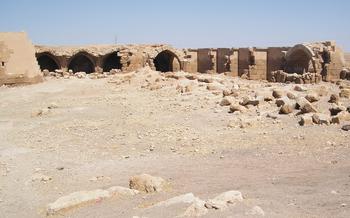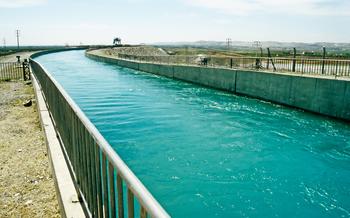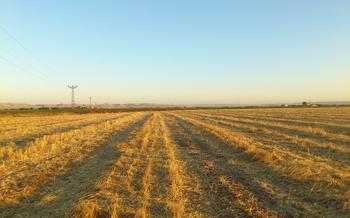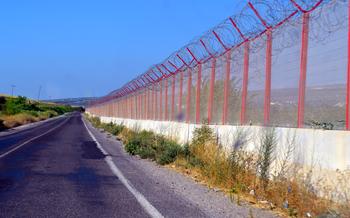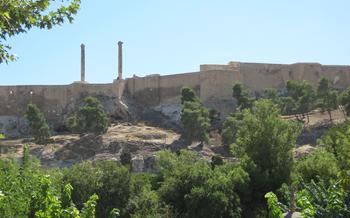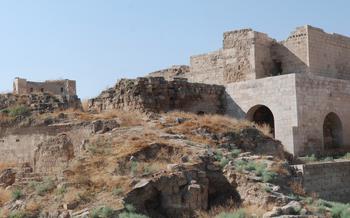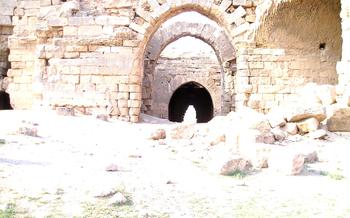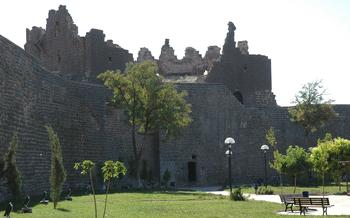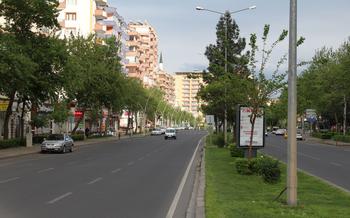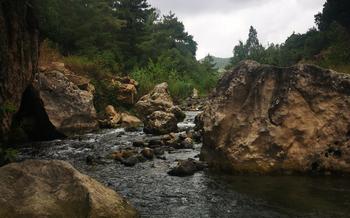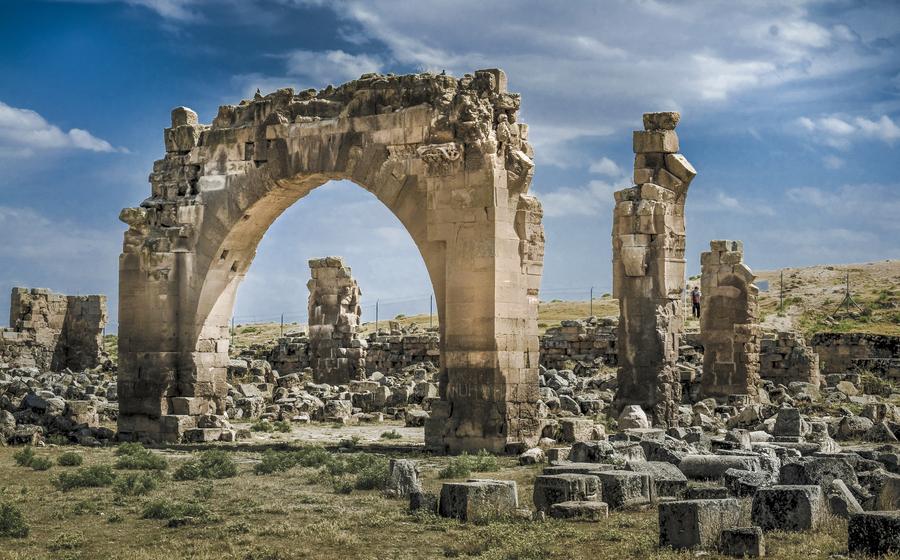
Harran University Ruins
- Harran University Ruins: A Journey Through History
- Exploring the Beehive Houses of Harran
- Harran Plain: A Fertile Oasis in the Desert
- The Great Mosque of Harran: A Symbol of Islamic Heritage
- Harran's Culinary Delights: A Taste of Local Flavors
- Exploring the Harran Bazaar: A Shopping Adventure
- The Legendary Pools of Harran: A Natural Wonder
- Mount Nemrut: A Majestic Summit for History Buffs
- Birecik Castle: A Symbol of Strength and Resilience
- Siverek Castle: A Hidden Gem of Historical Significance
- Eyyubi Mosque: A Masterpiece of Islamic Architecture
- Harran Museum: A Treasure Trove of Ancient Artifacts
- Experience the Warmth of Harran's Hospitality
- Planning Your Trip to Harran: Essential Tips
- Insider Tip: Discover the Hidden Oasis of Balikligol
- Practical Information for Visiting Balikligol:
Harran University Ruins: A Journey Through History
The ancient city of Harran, located in southeastern Turkey, is home to a remarkable historical treasure: the ruins of Harran University. Founded in the 6th century AD, this renowned institution of learning was one of the most prestigious centers of scholarship and education in the Islamic world. Its reputation extended far and wide, attracting students from across the Middle East and beyond.
The ruins of Harran University stand as a testament to the city's rich cultural heritage and its role as a hub of intellectual pursuits. Visitors can explore the remains of classrooms, libraries, and dormitories, as well as a large courtyard that once served as a gathering place for students and scholars. The architectural features of the university, including intricate carvings and decorative elements, offer a glimpse into the artistic and cultural traditions of the Islamic Golden Age.
The university's legacy goes beyond its physical remains. Harran was a center of learning in various fields, including astronomy, mathematics, philosophy, medicine, and theology. Its scholars made significant contributions to the advancement of knowledge and played a crucial role in shaping the intellectual landscape of the medieval Islamic world.
To reach Harran University ruins, visitors can take a bus or taxi from the nearby city of Şanlıurfa. The site is open to the public, and there is a small entrance fee. Local guides are available to provide tours and share insights into the history and significance of this remarkable institution of learning.
Exploring the Beehive Houses of Harran
Unique architectural style: The beehive houses of Harran are a distinctive feature of the region, characterized by their unique conical shape and construction. Built using mud bricks and straw, these houses have a circular base and a domed roof, resembling the shape of a beehive. The thick walls provide insulation, keeping the interiors cool in the summer and warm in the winter, making them well-suited to the region's climate.
Historical background and significance: The beehive houses of Harran have a long history, dating back to ancient civilizations. They were first constructed by the Arameans around the 10th century BC and have been continuously inhabited since then. The houses have survived various historical periods and civilizations, including the Romans, Byzantines, and Ottomans, each leaving their mark on the architectural style and design.
Cultural significance and local traditions: The beehive houses hold significant cultural value for the people of Harran. They represent the region's unique identity and are a symbol of its rich history. Local traditions and customs are closely intertwined with these houses, including traditional construction techniques, storytelling, and culinary practices. The beehive houses are not just homes but also serve as community spaces, where locals gather for social events and celebrations.
Tips for visiting and experiencing the beehive houses: - Visit the Harran Beehive Houses Museum to learn about their history and significance. - Take a guided tour to gain insights into the construction techniques and cultural traditions associated with the beehive houses. - Stay overnight in one of the restored beehive houses to experience the unique atmosphere and tranquility of these ancient dwellings. - Engage with the locals to learn about their daily lives and the stories behind the beehive houses.
Harran Plain: A Fertile Oasis in the Desert
Lying amidst the vast expanse of the Syrian Desert, the Harran Plain stands as an unexpected oasis of life and fertility. Its unique geographical features and temperate climate have nurtured a rich agricultural heritage, making it a crucial hub for local produce. The plain's fertile soil and abundant water resources have allowed for the cultivation of diverse crops, including wheat, barley, lentils, and a variety of fruits and vegetables.
Archaeological excavations have revealed a wealth of ancient settlements and artifacts scattered across the Harran Plain, hinting at the region's significance in past civilizations. The discovery of ancient irrigation systems and water management techniques speaks to the ingenuity and resilience of the people who once inhabited this land. The plain's strategic location along trade routes also contributed to its prosperity, facilitating the exchange of goods and ideas with neighboring regions.
In recent years, the Harran Plain has emerged as a destination for ecotourism, attracting visitors interested in sustainable practices and responsible travel. The region's unique ecosystem and diverse wildlife, including migratory birds and endangered species, offer opportunities for nature enthusiasts to explore and learn about the fragile beauty of the desert environment. Sustainable farming practices and community-based initiatives are also being implemented to preserve the region's natural resources and support local livelihoods.
The Great Mosque of Harran: A Symbol of Islamic Heritage
The Great Mosque of Harran stands as a testament to the rich Islamic heritage of the city. Built in the 8th century AD, this architectural masterpiece showcases intricate craftsmanship and embodies the spirit of Islamic architecture. Its unique design, featuring a square courtyard surrounded by arcades and a central prayer hall, reflects the architectural influences of the Umayyad Caliphate.
The mosque holds immense religious significance as a place of worship and pilgrimage for Muslims. Throughout history, devout pilgrims from across the region have flocked to the mosque to offer prayers and seek spiritual guidance. The Great Mosque has long been a center of religious learning and scholarship, contributing to the city's reputation as a renowned center of Islamic knowledge.
Beyond its religious significance, the mosque also holds cultural and historical value. It serves as a reminder of Harran's rich past, when the city was a thriving center of trade and learning. The mosque's architecture and design offer insights into the craftsmanship and artistic traditions of the period. Locals take great pride in the mosque, considering it a symbol of their cultural heritage and a source of inspiration.
For visitors, exploring the Great Mosque of Harran is a must. The mosque's serene atmosphere and intricate architecture create a captivating experience. Visitors are welcome to enter the mosque, marvel at its beauty, and learn about its historical significance. It's important to dress respectfully and observe local customs when visiting the mosque.
Harran's Culinary Delights: A Taste of Local Flavors
When it comes to culinary experiences, Harran offers a tantalizing blend of traditional dishes and unique flavors that reflect its rich history and cultural influences. The city's cuisine is renowned for its use of fresh, local ingredients and traditional cooking techniques that have been passed down through generations.
- Traditional Dishes and Ingredients:
- Experience the iconic dish of Harran, "şıllık", a delicious stew made with lamb or beef, vegetables, and spices, slow-cooked to perfection. Other must-try dishes include "sıkma", a type of flatbread topped with ground meat and vegetables, and "keşkek", a hearty dish made from bulgur, meat, and yogurt.
-
Harran is also famous for its wide variety of local ingredients, including unique spices, herbs, and vegetables that add distinctive flavors to the local cuisine.
-
Famous Street Food and Local Delicacies:
- Indulge in the city's vibrant street food scene, where you can sample mouthwatering delicacies such as "lahmacun", a thin and crispy flatbread topped with minced meat and vegetables, and "künefe", a sweet pastry filled with shredded phyllo dough, nuts, and syrup.
-
Don't miss the chance to try "çiğ köfte", a spicy raw meatball dish made with bulgur, spices, and herbs, and "şalgam", a fermented turnip juice that is a local favorite.
-
Culinary History and Cultural Influences:
- Harran's cuisine reflects the city's rich history and diverse cultural influences. Over the centuries, the city has been home to various civilizations, each of which has left its mark on the local culinary traditions.
-
From the ancient Mesopotamians to the Romans, Byzantines, and Arabs, each culture has contributed unique flavors and ingredients to the city's cuisine, creating a diverse culinary landscape that is unlike any other.
-
Recommendations for Local Restaurants and Markets:
- For an authentic Harran dining experience, visit local restaurants that specialize in traditional dishes. Some popular recommendations include "Şanlıurfa Sofrası" and "Tarihi Harran Mutfağı".
- To immerse yourself in the local culinary culture, explore the city's vibrant markets, where you can find fresh produce, spices, and local delicacies. The "Harran Pazarı" is a must-visit for food enthusiasts.
Exploring the Harran Bazaar: A Shopping Adventure
Immerse yourself in the vibrant atmosphere of the Harran Bazaar, a bustling marketplace where locals and visitors alike come together to trade goods and experience the rich cultural heritage of the region. Discover an array of local handicrafts, from intricate textiles and carpets to hand-painted ceramics and copperware. Savor the sweet aroma of freshly ground spices, and indulge in the taste of traditional sweets and delicacies, such as the famous "Harran böreği."
Bargaining Tips and Cultural Etiquette
Embrace the local custom of bargaining when making purchases at the bazaar. Politely negotiate prices with vendors, but remember to be respectful and fair in your offers. Observe local customs and traditions by dressing modestly and showing respect for the local culture.
Tips for Finding Hidden Gems and Interacting with Locals
Venture beyond the main market streets to discover hidden gems and unique souvenirs in the smaller alleys and shops. Engage with the friendly locals, who are always eager to share stories and insights about their culture and traditions. Learn a few Turkish phrases to enhance your interactions and show your appreciation for their hospitality.
The Legendary Pools of Harran: A Natural Wonder
The Pools of Harran are a series of natural pools located near the city of Harran in southeastern Turkey. These pools are a geological marvel, formed by the convergence of hot springs and cold groundwater. The pools are a popular destination for both locals and tourists, who come to swim in the warm waters and enjoy the stunning scenery.
The pools are also a site of historical and cultural significance. They have been used for bathing and healing purposes for centuries, and are mentioned in ancient texts such as the Bible. The pools are also associated with the legendary Abraham, who is said to have stopped here on his journey from Ur to Canaan.
The Pools of Harran are a unique and beautiful natural wonder, and are a must-see for any visitor to the region.
Practical Information for Visiting the Pools:
- The Pools of Harran are located about 10 kilometers from the city of Harran.
- The pools are open to the public year-round, and there is no entrance fee.
- There are changing rooms and showers available at the pools, and you can rent towels and swimming suits if needed.
- The pools are a popular spot for swimming, picnicking, and relaxing.
- There are several restaurants and cafes in the area, where you can enjoy a meal or a snack.
Mount Nemrut: A Majestic Summit for History Buffs
Historical Significance and Ancient Ruins Perched atop a mountain peak in the heart of southeastern Turkey, Mount Nemrut stands as a testament to the grandeur of the ancient Kingdom of Commagene. Ascend to the summit and marvel at the colossal statues of King Antiochus I, flanked by lions and eagles, that have guarded this sacred site for over two millennia. Explore the remnants of the royal tomb and the surrounding terraces, adorned with intricate reliefs that depict scenes from Greek mythology and the life of Antiochus himself.
Cultural Heritage and the Kingdom of Commagene Mount Nemrut is not just a historical site but also a symbol of the rich cultural heritage of the Commagene Kingdom. Established in the 1st century BC, this Hellenistic kingdom was a blend of Persian, Greek, and Armenian influences. The ruins of Nemrut provide a glimpse into the kingdom's unique culture and its devotion to the divine ruler cult of Antiochus I.
Breathtaking Views and Scenic Landscapes Beyond its historical significance, Mount Nemrut offers breathtaking panoramic views of the surrounding landscapes. From the summit, gaze across the vast expanse of the Anatolian plains, dotted with ancient ruins and villages. The sunrise and sunset views from the mountaintop are particularly spectacular, painting the horizon in vibrant hues of gold and purple.
Tips for Visiting Mount Nemrut and Planning Your Trip To fully appreciate the grandeur of Mount Nemrut, plan your visit during the summer months when the weather is clear and pleasant. The ascent to the summit can be challenging, but the reward is worth the effort. Consider hiring a local guide to learn more about the history and significance of the site. Remember to bring comfortable shoes, warm clothing, and plenty of water for your journey.
Birecik Castle: A Symbol of Strength and Resilience
Birecik Castle, located in the town of Birecik, Şanlıurfa, Turkey, stands as a testament to the region's rich history and strategic importance. This formidable fortress, perched atop a hill overlooking the mighty Euphrates River, has witnessed countless battles, sieges, and the rise and fall of civilizations throughout the centuries.
Constructed in the 6th century AD by the Byzantine Emperor Justinian I, Birecik Castle served as a vital defensive outpost against invading forces from the east. Its commanding position allowed it to control river traffic and trade routes, making it a key military stronghold in the region. Over the centuries, the castle underwent modifications and additions by various rulers, including the Arabs, Crusaders, and Ottomans, each leaving their mark on its architectural fabric.
Birecik Castle's impressive fortifications include towering walls, sturdy towers, and a complex system of gates and passages. Its strategic location provided a panoramic view of the surrounding landscape, allowing defenders to spot approaching enemies from afar. The castle's resilience is evident in its ability to withstand numerous attacks and sieges throughout history, solidifying its reputation as an impregnable fortress.
Today, Birecik Castle stands as a magnificent monument to the region's rich past. Visitors can explore its ruins, marvel at its architectural features, and soak in the breathtaking views of the Euphrates River and the surrounding countryside. The castle's historical significance and picturesque setting make it a must-visit destination for anyone interested in history, culture, and stunning natural landscapes.
Siverek Castle: A Hidden Gem of Historical Significance
Nestled in the charming town of Siverek, the ancient Siverek Castle stands as a testament to the region's rich history and cultural heritage. While lesser-known compared to other attractions in Şanlıurfa, this hidden gem offers a captivating glimpse into the past.
Built in the 12th century, Siverek Castle served as a strategic military stronghold during the Artuqid dynasty. Its imposing walls and towers once protected the town from invaders, and its commanding position atop a hill provided a panoramic view of the surrounding landscape.
Over the centuries, the castle underwent several renovations and additions, reflecting the architectural influences of different periods. Its unique blend of Islamic and Byzantine elements showcases the cultural diversity that has shaped the region.
Today, Siverek Castle stands as a symbol of resilience and strength, having withstood the test of time and numerous conflicts. Visitors can explore its well-preserved ruins, admire the intricate carvings and inscriptions that adorn its walls, and revel in the breathtaking views from its ramparts.
To fully appreciate the castle's significance, consider hiring a local guide who can share insights into its history and architectural features. The town of Siverek itself is a treasure trove of cultural experiences, offering traditional Turkish cuisine, vibrant markets, and friendly locals who are eager to share their stories.
Whether you're a history buff, an architecture enthusiast, or simply seeking off-the-beaten-path adventures, Siverek Castle is a must-visit destination that promises an unforgettable experience.
Eyyubi Mosque: A Masterpiece of Islamic Architecture
In the heart of Şanlıurfa, the Eyyubi Mosque stands as a testament to the city's rich Islamic heritage. Built in the 12th century by the Ayyubid dynasty, this architectural marvel boasts intricate carvings, stunning calligraphy, and a majestic dome. Its minaret, a beacon of faith, rises gracefully towards the heavens, inviting the faithful to prayer.
Step inside the mosque and be captivated by the serene atmosphere that envelops you. The spacious prayer hall, adorned with elegant arches and intricate tilework, creates a sense of awe and tranquility. The mihrab, the niche indicating the direction of Mecca, is adorned with exquisite carvings and Quranic verses, showcasing the mosque's dedication to Islamic tradition.
Beyond its religious significance, the Eyyubi Mosque holds immense cultural value for the people of Şanlıurfa. It serves as a gathering place for the community, where locals come together for prayers, celebrations, and religious teachings. The mosque's architecture and design have influenced countless other structures in the region, leaving a lasting legacy on the city's architectural landscape.
For visitors, the Eyyubi Mosque offers a glimpse into the vibrant Islamic heritage of Şanlıurfa. Whether you're a history buff, an architecture enthusiast, or simply seeking a moment of spiritual reflection, this sacred space is sure to leave a lasting impression.
Harran Museum: A Treasure Trove of Ancient Artifacts
Step into the Harran Museum, a treasure trove of ancient artifacts that narrates the rich cultural heritage of Şanlıurfa. Dive into history as you explore its collection of relics, including pottery, sculptures, and inscriptions dating back to the Neolithic era. Discover the secrets of ancient civilizations that once flourished in this region.
The museum showcases a fascinating array of artifacts, providing glimpses into the daily lives, religious practices, and artistic traditions of Harran's inhabitants. Admire the intricate pottery adorned with unique motifs, marvel at the finely carved sculptures depicting mythical creatures, and decipher ancient inscriptions that hold clues to the past.
Take advantage of the museum's educational exhibits to deepen your understanding of Harran's cultural heritage. Interactive displays and informative panels bring the ancient world to life, making history tangible and accessible. Learn about the region's role as a crossroads of civilizations, where different cultures converged and exchanged ideas.
Plan your visit to the Harran Museum to coincide with special events or temporary exhibitions that delve into specific aspects of the region's history. Whether you're a seasoned archaeologist or simply curious about the past, the Harran Museum offers a journey through time that will captivate and inspire.
Experience the Warmth of Harran's Hospitality
Harran's people are renowned for their warm hospitality and welcoming nature. They take pride in sharing their culture and traditions with visitors, ensuring a memorable and enriching experience. As you explore the city, be prepared to encounter friendly locals who are always willing to lend a helping hand, provide directions, or simply share a cup of tea and conversation.
To fully immerse yourself in Harran's culture, take the time to interact with the locals. Visit the local markets, where you can engage with vendors and learn about traditional crafts and products. Participate in local festivals and events, which are a vibrant display of Harran's rich heritage and customs. Engage in conversations with the locals, who are eager to share stories, anecdotes, and insights into their daily lives.
Respecting cultural norms and customs is essential when traveling to Harran. Dress modestly, avoid public displays of affection, and be mindful of local customs and traditions. Learn a few basic Turkish phrases to show your respect and willingness to engage with the locals.
For an authentic Harran experience, consider staying in a local guesthouse or homestay. This is an excellent way to interact with local families, learn about their way of life, and savor delicious home-cooked meals. You'll also have the opportunity to participate in daily activities and experience the warmth and hospitality of Harran firsthand.
Planning Your Trip to Harran: Essential Tips
Timing is Everything:
The best time to visit Harran is during the shoulder seasons, from April to May and from September to October, when the weather is pleasant and the crowds are smaller. In the summer, temperatures can soar, while in the winter, they can drop significantly, making it uncomfortable to explore the city.
Accommodation Options:
Harran offers a range of accommodation options to suit different budgets and preferences. For a truly authentic experience, consider staying in one of the traditional beehive houses, which have been converted into guesthouses. These unique structures provide a glimpse into the region's rich cultural heritage.
Getting Around:
The most convenient way to get around Harran is by renting a car, which gives you the freedom to explore the city and its surroundings at your own pace. Several local car rental agencies offer competitive rates, and the roads are generally well-maintained.
Packing Essentials:
When packing for your trip to Harran, be sure to include comfortable walking shoes, as you will be doing a lot of exploring on foot. Sunglasses, sunscreen, and a hat are essential for protection from the sun, while a light jacket or sweater is recommended for the cooler evenings.
Insider Tip: Discover the Hidden Oasis of Balikligol
Just a short drive from Harran, you'll find a hidden gem that's a must-visit for nature enthusiasts and pilgrims alike: Balikligol. This tranquil oasis is a natural pool fed by freshwater springs, teeming with thousands of sacred carp that are believed to have healing powers. According to local legend, these fish were once ordinary carp that transformed into sacred beings after being blessed by the Prophet Abraham.
Balikligol holds a special place in the hearts of both Muslims and Christians as a site of pilgrimage. The pool is surrounded by lush gardens and serene walkways, inviting visitors to relax and soak in the tranquil atmosphere. You can feed the fish, marvel at their shimmering scales, and take a moment to reflect on the cultural and religious significance of this unique place.
Practical Information for Visiting Balikligol:
-
Location: Balikligol is located about 20 kilometers from Harran. You can easily reach it by car or taxi.
-
Entrance Fee: There is a small entrance fee to visit Balikligol, which helps maintain the site.
-
Visiting Hours: Balikligol is open to visitors daily, from morning until evening.
-
Respectful Attire: When visiting Balikligol, it's important to dress modestly and respectfully, as it is a religious site.
-
Photography: Photography is allowed at Balikligol, but please be mindful of other visitors and the sacred nature of the site.
-
Local Cuisine: After your visit, be sure to sample the delicious local cuisine at one of the nearby restaurants.
